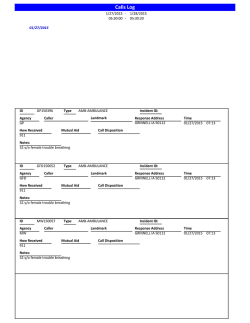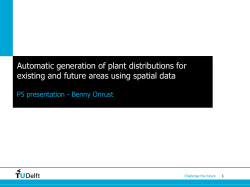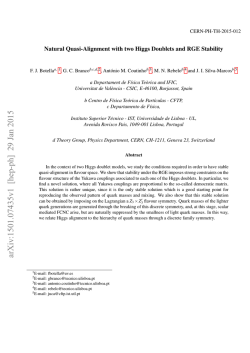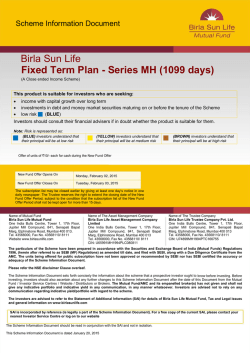
Gait Feature Subset Selection by Mutual Information
Gait Feature Subset Selection by Mutual Information
Baofeng Guo and Mark. S. Nixon
Abstract— Feature selection is an important pre-processing
step for pattern recognition. It can discard irrelevant and
redundant information that may not only affect a classifier’s
performance, but also tell against system’s efficiency. Meanwhile, feature selection can help to identify the factors that
most influence the recognition accuracy. The result can provide
valuable clues to understand and reason what is the underlying
distinctness among human gait-patterns. In this paper, we
introduce a computationally-efficient solution to the problem
of human gait feature selection. We show that feature selection
based on mutual information can provide a realistic solution for
high-dimensional human gait data. To assess the performance
of the proposed approach, experiments are carried out based on
a 73-dimensional model-based gait features set and a 64 by 64
pixels model-free gait symmetry map. The experimental results
confirmed the effectiveness of the method, removing about 50%
of the model-based features and 95% of the symmetry map’s
pixels without significant accuracy loss, which outperforms
correlation and ANOVA based methods.
I. I NTRODUCTION
Human gait recognition is to identify a person through
the pattern or style of walking. This technique becomes quite
appealing when it is difficult to get other biometrics information at the resolution required [1]. The information contained
in gait data, no matter the spatial-temporal measurements,
such as step length, cycle time, etc., or the kinematic
measurements, such as joint rotation and angles of the hip,
knee , ankle, etc., all can reflect human body’s distinct status
and differ from each other to some extent. There is also
evidence in medical and psychophysics studies, showing that
human gait can be unique under certain circumstances [1],
[2]. Therefore, since the 1990s gait recognition has received
significant attention [3], [4].
Approaches to extract gait features can be roughly categorized as two classes: model-based and model-free methods.
The model-based methods analyze the structures underlying
the gait data, and extract measurable parameters, such as
the kinematic values. Model-free methods generally consider
the motion pattern of human body holistically, such as the
silhouette pictures. However, no matter the model-based or
the model-free methods, the extracted features could be
quite high dimensional. This is partly for the reasons of
opaqueness in the understanding gait’s distinctness and to
obtain as much useful information as possible. For example,
the feature vectors in a model-based method [5], [6] have 73
components, let alone the model-free silhouette-based data
This work was support by ARL/MoD through IBM on the Information
Technology Alliance research programme.
Baofeng Guo and Mark. S. Nixon are with Information: Signals, Images,
Systems (ISIS) Research Group, School of Electronics and Computer Science, University of Southampton, Southampton SO17 1BJ, United Kingdom,
(email:{bg|msn}@ecs.soton.ac.uk).
978-1-4244-1597-7/07/$25.00 ©2007 IEEE
[7]–[9] that is usually a picture with the size such as 64 by
64 pixels.
Such high-dimensional feature (or data) spaces present
several problems to gait recognition. First, it may affect
the performance of many classification methods. Although
some techniques, such as the k-nn method, may less suffer
from this problem, it becomes severe for those probabilitybased algorithms, i.e., the so called ‘curse of dimensionality’ [10]. Second, due to the existence of many gaitrelated factors, e.g., health, age, body size, weight, speed,
etc., plus the opaqueness in understanding the underlying
recognition mechanism, many redundant features tend to
be included to avoid any loss of useful information. For
instance, we can argue that many model-based parameters
are actually correlated to each other more or less, such as
the hip and knee rotation. This is also true in the case of
silhouette-based data, where it is known that the majority
of pixels in the background area are useless. Finally, highdimensional data always imposes requirements for storage
space, computational load and communication bandwidth,
which become vital factors in the actual deployment of a
real-time system.
It is therefore advantageous to identify the important
features for gait recognition, and then remove those features
which convey little or redundant information. This can be
implemented by feature selection [11], [12] or other dimensionality reduction techniques. Apart from meeting the
computational challenges, interpretation of these identified
key-features can also provide valuable clues or some insights, which are useful to understand what is the intrinsic mechanism regarding the gait’s uniqueness. Previous
researches in gait feature selection [2]–[4], [9], [13]–[16]
have mainly considered the conventional statistical-tools,
such as principal component analysis (PCA) and analysis of
variance (ANOVA). However, there are still some remaining
challenges for gait feature selection. PCA is a popular
technique in dimensionality reduction, but this transform is
not optimized for class separability. This means that the
identified features may not coincide with the discriminatory
information that recognition really requires. The PCA-based
techniques also cannot directly pick up the important features, and have to resort to other extra strategies [9], which
will further reduce the accuracy. The ANOVA technique can
help to identify the features based on a null hypothesis test.
But the difference between classes highlighted by ANOVA
is mainly carried out by examining whether the population
mean vectors are the same, so it lacks the explicit or definite
relation with the recognition accuracy.
In this paper, we consider feature selection for gait recog-
nition from point of view of information theory. Like many
separability measures, mutual information (MI) evaluates the
statistical dependence between two random variables and so
can be used to measure the utility of selected features to
recognition. The advantages of the MI-based feature selection are its close relation with the desired Bayes error, a wellfound theoretical framework and efficient implementation
strategy [17], [18].
The remainder of this paper is organized as follows.
We first briefly review two conventional metrics for feature
selection in Section II. Then we introduce the MI-based
feature selection in Section III. To assess the performance of
these methods, we implement gait feature selection based on
a 73-dimensional model-based feature set and a 64×64 pixels
(model-free) symmetry map, respectively. Experiments are
carried out to compare the MI-based method with the traditional correlation-based and ANOVA-based methods. The
results are shown in Section IV. Finally, conclusions and
discussions are given in Section V.
II. S TATISTICAL METHODS FOR GAIT FEATURE
SELECTION
The objective of feature selection is to find a subset of
features, satisfying a certain criterion. In pattern recognition,
a nature selection metric will be the classification accuracy or
inversely the Bayes classification error. But direct minimization of the Bayes error cannot be analytically performed, so a
wide range of alternative statistics that are easier to evaluate
have been proposed. Two typical measures used in the gait
feature selection are introduced as follows:
1) In statistics, Analysis of variance (ANalysis Of VAriance, ANOVA) is a general method for studying
sampled-data relationships, in which the observed variance is partitioned into components due to different explanatory variables, such as between-class and withinclass variance. ‘One-way ANOVA’ is the simplest case,
and its purpose is to test for significant differences
between classes’ means. The F -test in ANOVA gives
a statistic to indicate to what extent the samples of
a variable are drawn from a distribution of the same
means, i.e., no differences between means of different
classes. It can be shown that this number, linked with
the between- and within-class variance (similar to the
Fisher’s linear discriminant), determines whether the
groups are actually different in the measured characteristic. This provides useful information for feature
selection.
2) Correlation indicates the strength and direction of a
linear relationship between two random variables. In
other words, correlation refers to the departure of two
variables from linear independence. Thus this metric
is also useful to investigate how far a feature departs
from the class label, and in a broad sense was used for
feature selection.
The existing techniques lack explicit and definite relation
with the classification accuracy or Bayes classification error,
and using them for gait feature selection may deviate from
the ideal solution. Hence, it is preferable to consider other
metrics which are able to detect more general dependency
in the data.
III. F EATURE SELECTION BASED ON MUTUAL
INFORMATION
In information theory, mutual information measures the
statistical dependence between two random variables and so
can be used to evaluate the relative utility of each feature to
classification [17]. Given the relationship between mutual information and Bayes classification error, the feature selected
by mutual information analysis is approaching to a criterion
by optimizing the Bayes error. Also, the implementation of
mutual information needs relatively lower computational cost
[18], which further makes it a convenient alternative metric.
A. Mutual information and entropy
The mutual information is a quantity that measures the
mutual dependence of the two variables, and is defined as:
p(x, y)
dx dy
(1)
p(x, y) log
I(X, Y ) =
p(x)
p(y)
Y X
where p(x, y) is the joint probability density function of
continual random variables X and Y , and p(x) and p(y)
are the marginal probability density functions respectively.
It is not difficult to find that mutual information is related to
entropy as:
I(X, Y ) = H(Y ) − H(Y |X)
(2)
given the Shannon entropy (discrete) defined as:
H(X) = −
p(x) log p(x)
(3)
X
The use of mutual information for feature selection can
be intuitively justified by the following arguments: Let Y
be variable standing for the class label (e.g., the subject’s
identity), and X a variable denoting the value for a gait
feature. The entropy H(Y ) is known to be a measure of
the amount of uncertainty about Y (i.e., the objective of
recognition), while H(Y |X) is the amount of uncertainty
left in Y when knowing an observation X. From (2), it
is seen that I(X, Y ) is the reduction in the uncertainty of
class label Y by the knowledge or measurement obtained at
gait feature X. Hence, mutual information can be interpreted
as the amount of information that the measurement at gait
feature X contains about the class label Y (see Venn diagram
in Fig. 1). In other words, MI is capable to reflect the
amount of information that a gait feature X contains about
the class label Y . Since the variable defined by class label Y
is the required classification result, the mutual information
measures the capability (in the sense of information theory)
of using this gait feature to predict the class label, i.e., the
subject’s identity.
Comparing with the statistical tools introduced in Section
II, we can see that the mutual information has more clear
and definite relation with the recognition objective. From the
point of view of statistics, the mutual information measures
more general dependency in the data, and therefore may lead
to better capability to feature selection.
Based on equation (9), to maximize I(x, Y ), x =
(X1 , X2 , . . . , XM ), the first variable can be chosen as:
X10 = max I (Xi , Y )
i
where Xk0 represents the result of maximization at step k.
Then, the second variable is chosen as:
H (Y )
H(Y|X)
I(X,Y) = H(Y) - H(Y|X)
X20 = max[I (Xi , Y ) −
i=1
Fig. 1.
i=1
Illustration of mutual information
B. Calculation of mutual information for feature selection
Feature selection based on MI can be described as follows:
Given a set of original data vectors x with M components
or variables, and Y the corresponding output class label
(e.g., the subject identity), find a subset variables x ⊂ x
with N components (N < M ) that maximizes MI I(x, Y ),
i.e., J(x0 ) = maxx⊂x I(x, Y ). The number of ways of
choosing N from the M features is M
N , which means that
a huge number of MI evaluations might be needed.
Aiming at this problem, we propose a gradient ascent
optimization strategy to maximize MI, described as follows.
First, we show that a multi-dimensional MI can be decomposed into a series of one-dimensional MIs:
Let x = (X1 , X2 , . . . , XM ) be a random vector representing the selected features Xi , i = 1, 2, . . . , M , and Y the
random variable corresponding to the class label. The mutual
information between them can be written as:
I(x, Y ) = I ((X1 , X2 , . . . , XM ) , Y )
I Xi , X10 +
I Xi , X10 |Y ]
i=1
The remaining variables are chosen in the same way until
the pre-specified number, N , of variables is reached:
Xn0
=
I Xi , Xj0
max[I (Xi , Y ) −
i=j
j
+
I
j
i=j
Xi , Xj0 |Y
]
i=j
where Xj0 , j = 1, 2, · · · , n − 1 are the variables already
selected.
The above strategy selects features sequentially, and so
avoids the problem of combinatorial explosion. At each step,
the next feature will be selected so as to maximize I(x, Y )
incrementally. This is a similar idea to the gradient ascent or
other hill-climbing algorithms.
(4)
If x only has two components, i.e., x = (X1 , X2 ), (4)
becomes:
I(x, Y ) = I((X1 , X2 ), Y )
= H(X1 , X2 ) − H(X1 , X2 |Y )
(5)
Fig. 2.
Illustration of one sequence in Southampton HiD gait database
From (2), we can derive the following two equations:
H(X1 , X2 ) = H(X1 ) + H(X2 ) − I(X1 , X2 )
(6)
and
H(X1 , X2 |Y ) = H(X1 |Y )+H(X2 |Y )−I(X1 , X2 |Y ) (7)
Substituting H(X1 , X2 ) and H(X1 , X2 |Y ) of (5) into (6)
and (7), we get:
I(x, Y ) = H(X1 , X2 ) − H(X1 , X2 |Y )
= H(X1 ) + H(X2 ) − I(X1 , X2 ) − H(X1 |Y )
−H(X2 |Y ) + I(X1 , X2 |Y )
I(Xi , Y ) − I(X1 , X2 ) + I(X1 , X2 |Y )
=
i=1,2
(8)
Extending (8) to more than two components, we have the
following equation:
I(Xi , Y ) −
I(x, Y ) =
i
I(Xi , Xj )
i
+
j=i
I(Xi , Xj |Y )
i
j=i
(9)
IV. E XPERIMENTS
To assess the MI-based gait feature selection, an indoor
Southampton HiD Gait database [4] (http://www.gait.
ecs.soton.ac.uk/database) was used. This database
consists of 2163 sequences from 116 subjects walking to
both the left and right. Each subject was filmed from a
fronto-parallel viewpoint at a resolution of 720×576 pixels,
in controlled laboratory conditions. The sequence is recorded
at a rate of 25 frames per second with approximately 90
frames per gait sequence. An example of this sequence is
shown in Fig. 2.
A. Gait feature sets
Based on this dataset, two approaches are employed to
obtain the gait features. The first approach is a modelbased method [5], which extracts a 73-dimensional measurement vector for each gait sequence (see some examples
in Fig. 3(a)), based on techniques such as adaptive model
and deformable contours. The detailed feature components
include 18 model parameters based on joint rotation models
(a)
Fig. 3.
(b)
(a) List of some geometric human body model parameters and their illustration [19]; (b) Example of a gait symmetry map.
for the hip, knee and ankle, and 28 parameters describing
the subjects’ speed, gait frequency, body proportions, etc.
The second approach is a model-free method based on
analyzing the symmetry of human motion [8]. This method
is reinforced from the psychologists’ view that human gait
is a symmetrical pattern of motion, and therefore suggest
symmetry is suitable for gait recognition. The generalized
symmetry operator was applied to locate features according
to their symmetrical properties without relying on the borders
of a shape or on general appearance. For each sequence, the
obtained gait signature is a 64 by 64 pixels symmetry map,
such as in Fig. 3(b).
B. Experimental results
Tests of recognition accuracy have been carried out to
assess the proposed feature selection method. Currentlypopular support vector machines (SVMs) [20], [21] were
chosen as the classifiers in these experiments since they
are less sensitive to the data’s dimensionality. Although
SVMs are used here, the proposed method is not limited to
this particular classifier and other classification algorithms
are also applicable.
Three feature selection methods, namely Pearson correlation [22], ANOVA [9] and the mutual information based
methods are implemented respectively, and then tested on
the above two feature sets to obtain the corresponding
recognition rate on the reduced feature subsets.
To calculate the selection metrics, i.e., the correlation
coefficients, one-way ANOVA’s f -statistics and MI, half of
the sequences from each subject were randomly chosen as the
training set. This training set is assumed as the known data
samples, and then can be used for multiple purples, such as to
learn the above selection metrics and validate the SVMs’ parameters. The remaining 50% sequences are assumed as the
unseen data to form the testing set on which the recognition
accuracy was assessed. Since SVMs are inherently binary
(two-class) classifiers, a ‘one-against-one’ scheme was used
with subsequent majority voting to give a multi-class result.
The kernel function used is an inhomogeneous polynomial,
and the SVMs’ parameters, i.e., polynomial order and the
penalty parameter C are chosen by a validation procedure
based on the training data.
The main objective of feature selection is to choose the
most ‘informative’ or ‘relevant’ features, and achieve the
possible highest recognition accuracy on the reduced feature
set. The experiments were thus designed to assess the change
of recognition accuracy as features are progressively selected
(i.e., the cumulative recognition rate). The feature selection
results for the model-based feature set are shown in Fig. 4,
where the line marked with ‘O’ represents the results of the
MI-based method, benchmarked by that of the correlationbased method (the line marked with ‘+’) and the ANOVAbased method (the line marked with ‘∆’). Data points are
at 2 features increments at each step. The random samplings
to generate the testing set and training set were repeated
10 times to allow an estimate of the error inherent in this
sampling process. The corresponding recognition rates with
their error bars (i.e., CCR ± stand deviation) are also shown
in Fig. 4.
From Fig. 4, it is seen that the feature subset selected by
the mutual information achieves a better recognition rate with
fewer model parameter than for the correlation and ANOVA
Correct Classfication Accuracy (%) ±Std
100
90
80
70
MI method
60
Correlation method
50
ANOVA method
40
30
20
10
Fig. 4.
10
20
30
40
Number of features selected
50
60
70
Cumulative recognition rates as the model-based features are progressively selected, accuracy (%) ± standard deviation.
TABLE I
T OP 15 SELECTED MODEL - BASED PARAMETERS BY USING THE THREE METHODS .
Rank
1
2
3
4
5
6
7
8
9
10
11
12
13
14
15
MI method
Ankle Width LWA
Leg Width 08
Hip Rotation Amplitude
Leg Width 01
Head dx HDX
Y Motion Amplitude Ay
Torso Width TW
Knee Width LWKU
Knee Rotation angle(02)
Gait Frequency omega
Knee Rotation angle(11)
Ankle Rotation angle(07)
Hip Rotation Mean
Knee Rotation angle(13)
Leg Width 03
Correlation method
Leg Width 08
Leg Width 09
Knee Width LWKU
Ankle Width LWA
Leg Width 07
Head Height HH
Knee Rotation angle(12)
Knee Rotation Mean
Head dx HDX
Knee Width LWKL
Knee Rotation angle(04)
Ankle Rotation angle(12)
Knee Rotation angle(03)
Leg Width 06
Ankle Rotation angle(06)
based methods. This is particularly significant when up to
35 features are selected. For example, the MI-based method
achieves 90% correct recognition rate with 25 features,
compared with 29 feature for the ANOVA-based method and
37 features for the correlation-based method. For the MIbased method, when more than 37 features (accounting for
about 50% of all 73 features) are selected, the recognition
rate then improves only slightly. This indicates that for this
particular model-based feature set, about 50% parameters are
almost redundant and can be removed without significant loss
of recognition accuracy. When more and more features are
selected, the differences between the three methods tend to
be small. This is because at this stage, most of the essential
features are already included. The results in Fig. 4 also
suggest that the ANOVA-based method is generally better
than the correlation-based method.
Table I further lists the names of the 15 top model-based
features selected by the mutual information, the correlation
and the ANOVA based methods, respectively. It is intuitively
suggested that the features selected by the mutual information seem to contain the wider range of gait information.
The feature selection results for the model-free gait symmetry pictures are shown in Fig. 5. The line marked with ‘O’
are the results of the MI-based method, comparing with the
correlation-based method (the line marked with ‘+’) and the
ANOVA method
Leg Width 08
Leg Width 09
Leg Width 04
Leg Width 05
Leg Width 07
Leg Width 06
Ankle Width LWA
Knee Width LWKL
Leg Width 03
Leg Width 01
Leg Width 00
Leg Width 02
Gait Frequency omega
Y Motion Amplitude Ay
Head dx HDX
ANOVA-based method (the line marked with ‘∆’). It is seen
that for the case of the MI-based method, the recognition rate
change little when more than 100 important symmetry pixels
are selected, which compares to 150 important pixels selected
by the ANOVA-based method. Moreover, the correlationbased method cannot reach the 95% accuracy rate that are
achieved by both the MI and the ANOVA-based methods,
after using about 200 pixels in the symmetry maps (these
account for about 5% in all 64×64 pixles). These empirical
findings are based on this specific dataset, so in real world
applications noise on the symmetry maps should be taken
into account.
From Fig. 5, it is seen that the cumulative recognition
results on the model-free gait data are consistent with our
previous findings in the model-based feature set (see Fig. 4),
with the best recognition rate achieved by the MI-based
method, followed by the ANOVA and the correlation based
methods. These results confirmed the effectiveness of using MI as the feature selection metric to approximate the
classification accuracy. On the other hand, the correlation
coefficient can only measure the strength and direction of
a linear relationship between two random variables. So it
is weaker to be validly used to infer the prediction accuracy
(i.e., no strong causal relationship between the variables), and
the poorest results were obtained among the three methods.
Correct Classfication Accuracy (%)
100
90
80
70
60
MI method
Correlation method
50
ANOVA method
40
30
20
10
0
0
100
200
300
400
500
600
Number of features selected
Fig. 5.
Cumulative recognition rates as the model-free symmetry pixels are progressively selected.
Standing in the middle of the performances, the method
based on the ANOVA was built on several assumptions,
such as normality of the distributions and homogeneity of
variances, which may reduce the robustness of the method
if such assumptions did not hold.
V. C ONCLUSIONS
In this paper, we presented a feature selection method
for gait recognition based on mutual information analysis.
This feature selection technique can effectively identify the
most pertinent features for classification purposes, and improve system’s efficiency accordingly. To assess the proposed
method, experiments were carried out on a model-based gait
feature set and a model-free symmetry gait data. The results
showed that the MI-based method has good application capability in gait feature selection, with fewer features that can
obtain good recognition accuracy. It also outperformed the
correlation-based and the ANOVA-based methods. Further
research is undergoing to explore the selected results to
understand the underlying distinctness among human gaits.
Currently, the algorithms were tested on the indoor
Southampton HiD Gait database, which was filmed in controlled laboratory conditions. To obtain more general results
for different surface types, times, clothings, etc., future
research will be carried out to test the algorithm on other
higher-variations datasets, such as the HumanID gait dataset
[2].
R EFERENCES
[1] A. Kale, A. Sundaresan, A. N. Rajagopalan, N. P. Cuntoor, A. K.
Roy-Chowdhury, V. Krger, and R. Chellappa. Identification of humans
using gait. IEEE Transactions on Image Processing, 13(9):1163–1173,
2004.
[2] Z. Liu and S. Sarkar. Improved Gait Recognition by Gait Dynamics
Normalization. IEEE Transactions on Pattern Analysis and Machine
Intelligence, 28(6):863–876, 2006.
[3] S. Sarkar, P. J. Phillips, Z. Liu, I. R .Vega, P. Grother, and K. W.
Bowyer. The HumanID Gait Challenge Problem: Data Sets, Performance, and Analysis. IEEE Transactions on Pattern Analysis and
Machine Intelligence, 27(2):162–177, 2005.
[4] M. S. Nixon and J. N. Carter. Automatic recognition by gait.
Proceedings of the IEEE, 94(11):2013–2024, 2006.
[5] D. K. Wagg and M. S. Nixon. Automated markerless extraction
of walking people using deformable contour models. Computer
Animation and Virtual Worlds, 15(3-4):399–406, 2004.
[6] C. Yam, M. Nixon, and J. Carter. Automated person recognition by
walking and running via model-based approaches. Pattern Recognition, 37(5):1057–1072, 2004.
[7] L. Wang, T. Tan, H. Ning, and W. Hu. Silhouette analysis-based gait
recognition for human identification. IEEE Transactions on Pattern
Analysis and Machine Intelligence, 25(12):1505–1518, 2003.
[8] J. Hayfron-Acquah, M. S. Nixon, and J. N. Carter. Automatic
gait recognition by symmetry analysis. Pattern Recognition Letters,
24:2175–2183, 2003.
[9] G. Veres, L. Gordon, J. N. Carter, and M. Nixon. What image information is important in silhouette-based gait recognition. In Proceedings
of IEEE Computer Vision and Pattern Recognition conference, pages –,
Washington, USA, 2005.
[10] G. Hughes. On the mean accuracy of statistical pattern recognizers.
IEEE Transactions on Information Theory, 14(1):55–63, 1968.
[11] A. Jain and D. Zongker. Feature selection: Evaluation, application, and
small sample performance. IEEE Transactions on Pattern Analysis and
Machine Intelligence, 19(2):153–158, 1997.
[12] A. Blum and P. Langley. Selection of relevant features and examples
in machine learning. Artificial Intelligence, 97(1–2):245–271, 1997.
[13] B. Bhanu and J. Han. Human recognition on combining kinematic and
stationary features. In Proceedings of the Fourth International Conference on Audio Visual Biometric Person Authentication, AVBPA03,
pages 600–608, 2003.
[14] A. Veeraraghavan, R. Chellappa, and A. Roy Chowdhury. Role of
shape and kinematics in human movement analysis. In Proceedings
IEEE Computer Vision and Pattern Recognition 2004, CVPR04, volume 1, pages 730–737, 2004.
[15] Z. Liu., L. Malave, A. Osuntogun, P. Sudhakar, and S. Sarkar. Toward
understanding the limits of gait recognition. Proceedings of SPIE,
5404:195–205, 2004.
[16] M. S. Nixon, T. N. Tan, and R. Chellappa. Human Identification based
on Gait, chapter 5, pages 45–104. Springer, 2005.
[17] F. Maes, A. Collignon, D. Vandermeulen, G. Marchal, and P. Suetens.
Multimodality image registration by maximization of mutual information medical imaging. IEEE Transactions on Medical Imaging,
16(2):187–198, 1997.
[18] B. Guo, S. R. Gunn, R. I. Damper, and J.D. B. Nelson. Band selection
for hyperspectral image classification using mutual information. IEEE
Geoscience and Remote Sensing Letters, 3(4):522–526, 2006.
[19] D. Wagg. Local and Global Models for Articulated Motion Analysis.
PhD thesis, School of Electronics and Computer Science, University
of Southampton,UK, 2006.
[20] B. E. Boser, I. M. Guyon, and V. N. Vapnik. A training algorithm for
optimal margin classifiers. In Proceedings of the Fifth Annual Workshop on Computational Learning Theory, pages 144–152, Pittsburgh,
PA, 1992.
[21] C. Cortes and V. N. Vapnik. Support-vector networks. Machine
Learning, 20(3):1–25, 1995.
[22] H. Abdi. in N.J. Salkind (ed.), Encyclopedia of Measurement and
Statistics, chapter Coefficients of correlation, alienation and determination. Thousand Oaks, CA: Sage, 2007.
© Copyright 2025






![arXiv:1501.06883v1 [nucl-ex] 27 Jan 2015](http://s2.esdocs.com/store/data/000469010_1-b3be2be1617ce0dc870c493784ed097f-250x500.png)